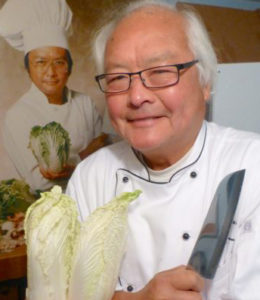Wok & Roll by Peter Kwong, (Frederic) Inter-County Leader
» Download this column as a Word document
When I was a restaurant consultant in Milwaukee, I helped a lot of restaurants fix their operation problems. Often the question was, “Why are the restaurants not making a profit?”
Of course, there are many reasons why — location, price, service, cleanliness — but mainly, it goes to the root of all problems: Do we have the right concept serving the food the public wants? And is the restaurant set up properly so it can operate effectively and efficiently? Without consciously knowing much about it, I was actually using the principles of feng shui in coming up with different logical solutions.
So, what is feng shui?

Growing up in Hong Kong, that term came up constantly. In straight translation, “feng” is wind, and “shui” is water. Hence, the directions of how and where the wind and water are flowing affect one’s future.
The folks in Hong Kong are dead serious about feng shui, and many feng shui masters are consulted before the construction of a building or picking a grave site to bury their elders. And the most common ones are to make sure that their own home carries a good feng shui flow.
I remember a story about a local bank that wanted to move to a new location, and they consulted a feng shui master to approve the blueprint, just to make sure all the elements were in harmony. And, lo and behold, everything guaranteed a prosperous future except the front entrance, which was facing the Main Street with the rails of the running trams, was considered to be bad feng shui, as it was too busy and disruptive, and might disturb the future peace and harmony of the business.
And guess what the bank did? They actually altered the front entrance so it would not face directly to the main road but sideways. Yes, in this day and age, one word from the master, and they would rather spend hundreds and thousands of extra dollars to ensure a prosperous future. And after all these years, business is now even better than expected.
So, who’s to believe?
Feng shui is the study of the heavens and the Earth in relation to humans. It has been around since the Qin Dynasty, the first emperor of China 221 to 207 B.C. It is the theory of five natural elements — metal, wood, water, fire and earth — and how they coexist in harmony and create a balance in the universe.
The metal, in the form of an ax or a saw, can destroy a forest. Yet, trees can stop a flood, but a fire can wipe out a forest. While fire can be put out by rain and the earth can slow down or even stop a flood, more so, the precious metals are hidden under the soil until they are unearthed. It is a balance of destruction and creation, all under the name of harmony.
I love to cook, and my kitchen has to have that flow of energy and efficiency. It is the same principle that I used with commercial kitchens. There are five elements to consider when we design a kitchen: how much food to bring in, where to store it, where to prepare it, where to cook it and how to serve it properly.
It has to have the right workflow. Can you imagine if you have to run back and forth to get the food from storage, then prep it on one end of the kitchen, just to run to the other end to store it? You catch my drift. Imagine all the unnecessary accidents that could happen.
The same applies to the front of the house. To see a server run around taking my order, just to run to the other end to ring it up, and to then run to the kitchen to get the food just drives me nuts! And to see some restaurants actually have their restrooms designed to face the dining room. Eew! I’ll say no more.
I teach about yin and yang with my cooking — the balance of colors, flavors and aromas that intrigue our senses. Instead of looking at just red or green, how about adding some white, yellow or other colors? And instead of just sweet or salty, how about a different sensation of sweet and sour? Folks love German potato salad and sweet and sour pork for that reason.
Yin is the feminine side of the elements — soft, dark, still, passive, blue and green in colors, empty spaces and curves. The yang is the masculine side — hard, bright, moving, active, warm red tones, solid structure and geometric lines. It is the balance of yin and yang that gives harmony in the surroundings.
Just as the restaurant needs a good workflow, our household needs the same, which we call chi. It is the energy flow that makes us feel good and refreshed. It is important to keep a good flow of chi in our home. Too much or not enough flow is unhealthy.
Think of a healthy river or lake. Too much water flow can cause a flood or erode the riverbanks. And stagnant water is worse, as insects will start to infest and the stench is unbearable.
With all that information, you can create your own healthy feng shui, how to keep the healthy air circulating in your house and how to keep the warm sunshine permeating your home.
In feng shui, there are a lot of rules and guidelines, but you can simplify the process. Just do it from your heart, and use your common sense.
Put hanging plants in windows that are too bright; put lights in corners that are too dark; avoid placing tables and chairs with sharp corners on paths that you can run into; or place an aquarium or a small water fountain in corners that need some life or movement.
Follow your heart, and do whatever you feel is comfortable and natural; the positive chi will follow. Have some fun and good luck.
Go to phkwong.com for more columns and to purchase his book, “Wok & Roll.”



